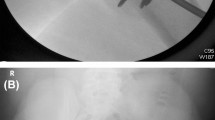Abstract
Background
In 2005, we reported removal of functional restriction after primary THA performed through the anterolateral approach did not increase the incidence of dislocation.
Questions/purposes
To develop a current practice guideline, we evaluated the incidence of early dislocation after primary THA after implementation of a no-restriction protocol.
Methods
Between January 2005 and December 2007, 2532 patients (2764 hips; 1541 women, 1223 men; mean age, 63.2 years [28–98 years]) underwent primary THA at our institution. Bilateral THA was performed in 232 patients (464 hips). The direct anterior or anterolateral approach was used in all patients. Femoral head size was 28, 32, or 36 mm. Patients were given no traditional functional restrictions postoperatively, such as use of elevated seats, abduction pillows, and restriction from driving. All patients received standard care at the judgment of the attending surgeon. One hundred forty-six patients missed followup appointments despite efforts to be contacted by telephone. The remaining 2386 of 2532 patients (94%) had a minimum followup of 6 months (mean, 14.2 months; range, 6–34 months).
Results
Four known dislocations occurred in the followed cohort of 2386 patients with 2612 hips (0.15%) at a mean of 5 days (3–12 days) postoperatively, none related to high-impact trauma. One dislocation occurred in a patient with a history of developmental dysplasia of the hip, two dislocations occurred while at the toilet (one with a previous hip fracture treated with a modular system), and one dislocation was idiopathic.
Conclusions
We confirmed a low incidence of dislocation after primary THA in the absence of early postoperative restrictions. We conclude a no-restriction protocol does not increase the incidence of early dislocation after primary THA.
Level of Evidence
Level II, therapeutic study. See the Guidelines for Authors for a complete description of levels of evidence.
Similar content being viewed by others
References
Ali Khan MA, Brakenbury PH, Reynolds IS. Dislocation following total hip replacement. J Bone Joint Surg Br. 1981;63:214–218.
Charnley J. Total hip replacement by low-friction arthroplasty. Clin Orthop Relat Res. 1970;72:7–21.
Hummel MT, Malkani AL, Yakkanti MR, Baker DL. Decreased dislocation after revision total hip arthroplasty using larger femoral head size and posterior capsular repair. J Arthroplasty. 2009;24(6 Suppl):73–76.
Kelley SS, Lachiewicz PF, Hickman JM, Paterno SM. Relationship of femoral head and acetabular size to the prevalence of dislocation. Clin Orthop Relat Res. 1998;355:163–170.
Khatod M, Barber T, Paxton E, Namba R, Fithian D. An analysis of the risk of hip dislocation with a contemporary total joint registry. Clin Orthop Relat Res. 2006;447:19–23.
Kwon MS, Kuskowski M, Mulhall KJ, Macaulay W, Brown TE, Saleh KJ. Does surgical approach affect total hip arthroplasty dislocation rates? Clin Orthop Relat Res. 2006;447:34–38.
Lubbeke A, Stern R, Garavaglia G, Zurcher L, Hoffmeyer P. Differences in outcomes of obese women and men undergoing primary total hip arthroplasty. Arthritis Rheum. 2007;57:327–334.
Mallory TH, Lombardi AV, Jr., Fada RA, Herrington SM, Eberle RW. Dislocation after total hip arthroplasty using the anterolateral abductor split approach. Clin Orthop Relat Res. 1999;358:166–172.
Masonis JL, Bourne RB. Surgical approach, abductor function, and total hip arthroplasty dislocation. Clin Orthop Relat Res. 2002;405:46–53.
Morrey BF. Difficult complications after hip joint replacement. Dislocation. Clin Orthop Relat Res. 1997;344:179–187.
Moskal JT, Mann JW, 3rd. A modified direct lateral approach for primary and revision total hip arthroplasty. A prospective analysis of 453 cases. J Arthroplasty. 1996;11:255–266.
Murray JE. Orientation-specific effects in picture matching and naming. Mem Cognit. 1999;27:878–889.
Paterno SA, Lachiewicz PF, Kelley SS. The influence of patient-related factors and the position of the acetabular component on the rate of dislocation after total hip replacement. J Bone Joint Surg Am. 1997;79:1202–1210.
Peak EL, Parvizi J, Ciminiello M, Purtill JJ, Sharkey PF, Hozack WJ, Rothman RH. The role of patient restrictions in reducing the prevalence of early dislocation following total hip arthroplasty. A randomized, prospective study. J Bone Joint Surg Am. 2005;87:247–253.
Peters CL, McPherson E, Jackson JD, Erickson JA. Reduction in early dislocation rate with large-diameter femoral heads in primary total hip arthroplasty. J Arthroplasty. 2007;22(6 Suppl 2):140–144.
Phillips CB, Barrett JA, Losina E, Mahomed NN, Lingard EA, Guadagnoli E, Baron JA, Harris WH, Poss R, Katz JN. Incidence rates of dislocation, pulmonary embolism, and deep infection during the first six months after elective total hip replacement. J Bone Joint Surg Am. 2003;85:20–26.
Ritter MA, Harty LD, Keating ME, Faris PM, Meding JB. A clinical comparison of the anterolateral and posterolateral approaches to the hip. Clin Orthop Relat Res. 2001;385:95–99.
Sayed-Noor AS, Hugo A, Sjoden GO, Wretenberg P. Leg length discrepancy in total hip arthroplasty: comparison of two methods of measurement. Int Orthop. 2009;33:1189–1193.
Talbot NJ, Brown JH, Treble NJ. Early dislocation after total hip arthroplasty: are postoperative restrictions necessary? J Arthroplasty. 2002;17:1006–1008.
Ververeli PA, Lebby EB, Tyler C, Fouad C. Evaluation of reducing postoperative hip precautions in total hip replacement: a randomized prospective study. Orthopedics. 2009;32:889–893.
Woo RY, Morrey BF. Dislocations after total hip arthroplasty. J Bone Joint Surg Am. 1982;64:1295–1306.
Author information
Authors and Affiliations
Corresponding author
Additional information
Javad Parvizi is a consultant for Stryker Orthopaedics (Mahwah, NJ) and has Intellectual Properties on SmarTech (Philadelphia, PA); Richard H. Rothman is a consultant for and receives royalties from Stryker Orthopaedics.
Each author certifies that his/her institution has approved the human protocol for this investigation and that all investigations were conducted in conformity with ethical principles of research.
About this article
Cite this article
Restrepo, C., Mortazavi, S.M.J., Brothers, J. et al. Hip Dislocation: Are Hip Precautions Necessary in Anterior Approaches?. Clin Orthop Relat Res 469, 417–422 (2011). https://doi.org/10.1007/s11999-010-1668-y
Published:
Issue Date:
DOI: https://doi.org/10.1007/s11999-010-1668-y




